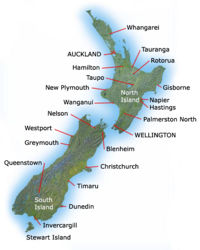Welcome to the Virtual Education Wiki ~ Open Education Wiki
New Zealand: Difference between revisions
| Line 19: | Line 19: | ||
== New Zealand education system == | == New Zealand education system == | ||
The education system in New Zealand is divided into | |||
# pre-school education, | |||
# primary education, | |||
# secondary education, | |||
# tertiary education | |||
Kindergarten education is usally run by private operators and not madatory provided for all children. Primary school goes up to year 6, intermediate school finishes at year 8 and secondary school is the remaining five years of schooling. Between the ages of 6 and 16 Primary and Secondary education is compulsory for students. | |||
== Higher education == | == Higher education == | ||
Revision as of 16:51, 17 December 2008
Partners situated in New Zealand
None.
New Zealand in a nutshell
New Zealand (Maori: Aotearoa) is an geographically isolated island country in the south-western Pacific Ocean. It comprises two main landmasses (the North Island and the South Island), and numerous smaller islands, most notably Stewart Island/Rakiura and the Chatham Islands. The Realm of New Zealand also includes the Cook Islands and Niue (self-governing but in free association); Tokelau; and the Ross Dependency (New Zealand's territorial claim in Antarctica).
The population of New Zealand is around 4.1 million according to the CIA Factbook. This makes it rather similar in size to several European countries, rather larger than Lithuania, slightly smaller than Ireland and rather smaller than Norway. In UK terms, it is slightly smaller than Scotland (5.0 million) and slightly larger than Wales (3.0 million). Thus population-wise as well as politically and economically it is a good match to these countries/regions.
The indigenous Māori being the largest minority, the population is mostly of European descent. Also significant minorities are Asians and non-Māori Polynesians, especially in the urban areas. As a Commonwealth country with strong historic links with the UK in general and Scotland in particular, Elizabeth II is the Head of State. In her absence, she is represented by a non-partisan Governor-General. Actually the position of Queen Elizabeth II is essentially symbolic, and she has no real political influence. Political power is rather held by the democratically elected Parliament of New Zealand under the leadership of the Prime Minister, who is the head of government.
New Zealand education policy
This is centralised. (More details needed.)
New Zealand education system
The education system in New Zealand is divided into
- pre-school education,
- primary education,
- secondary education,
- tertiary education
Kindergarten education is usally run by private operators and not madatory provided for all children. Primary school goes up to year 6, intermediate school finishes at year 8 and secondary school is the remaining five years of schooling. Between the ages of 6 and 16 Primary and Secondary education is compulsory for students.
Higher education
Universities in New Zealand
New Zealand has nine universities. Most used to be constituent colleges of the federal University of New Zealand but this was dissolved in 1961.
Universities
Table 1
| Name | Location | Foundation |
|---|
| University of Otago | Dunedin | 1869 |
| University Canterbury | Christchurch | 1873 |
| University of Auckland | Auckland | 1883 |
| Victoria- University Wellington | Wellington | 1897 |
| Massey-University | Palmerston North, Auckland, Wellington | 1927 |
| University of Waikato | Hamilton | 1964 |
| Unitec | Auckland | 1976 |
| Lincoln University | Lincoln, Canterbury | 1990 |
| Auckland University of Technology | Auckland | 2000 |
The total number of students at the Universities at New Zealand is about 170 000. University of Otago is deemed to be the oldest University in Country. Auckland University of Technology as the youngest University was founded in the year 2000, whose origin as technical school lies in the year 1895. At the smallest University of New Zealand – Lincoln University – are 4.100 students registered, at the largest – Massey University – study 42.000 peeople (As at 2003).
Until the year of 1961 the sole University of New Zealand (1870-1961) (Maori: Te Wananga o Aotearoa) as by law founded Organization concentrated several constituent colleges of higher education at various locations around New Zealand.
Polytechnics in New Zealand
There are also 23 polytechnics or institutes of technology in New Zealand. A useful NZQA observes:
- Polytechnics have traditionally specialised in vocational training, but that role has expanded over the last decade to meet the needs of learners and the economy. Many are involved in research activities, particularly in applied and technological areas and other degrees.
(Also say about Maori institutions.)
Higher education reform
The Bologna Process
(Not known. Relevant?)
Administration and finance
Centralised, similar to England.
Quality assurance
NZQA.
New Zealand HEIs in the information society
Towards the information society
Information society strategy
Benchmarking e-learning
New Zealand is the home of the eMM methodology, developed by Dr Stephen Marshall at the University of Wellington. He is a consultant to the UK Higher Education Academy Benchmarking Exercise. After a large amount of government-funded activity (see the 9 MB report) in 2004-2005, where nine institutions were benchmarked (six universities and three polytechnics), recently (up to summer 2007) there does not seem to be an externally funded benchmarking programme oriented to New Zealand tertiary institutions - but this situation may soon change.

